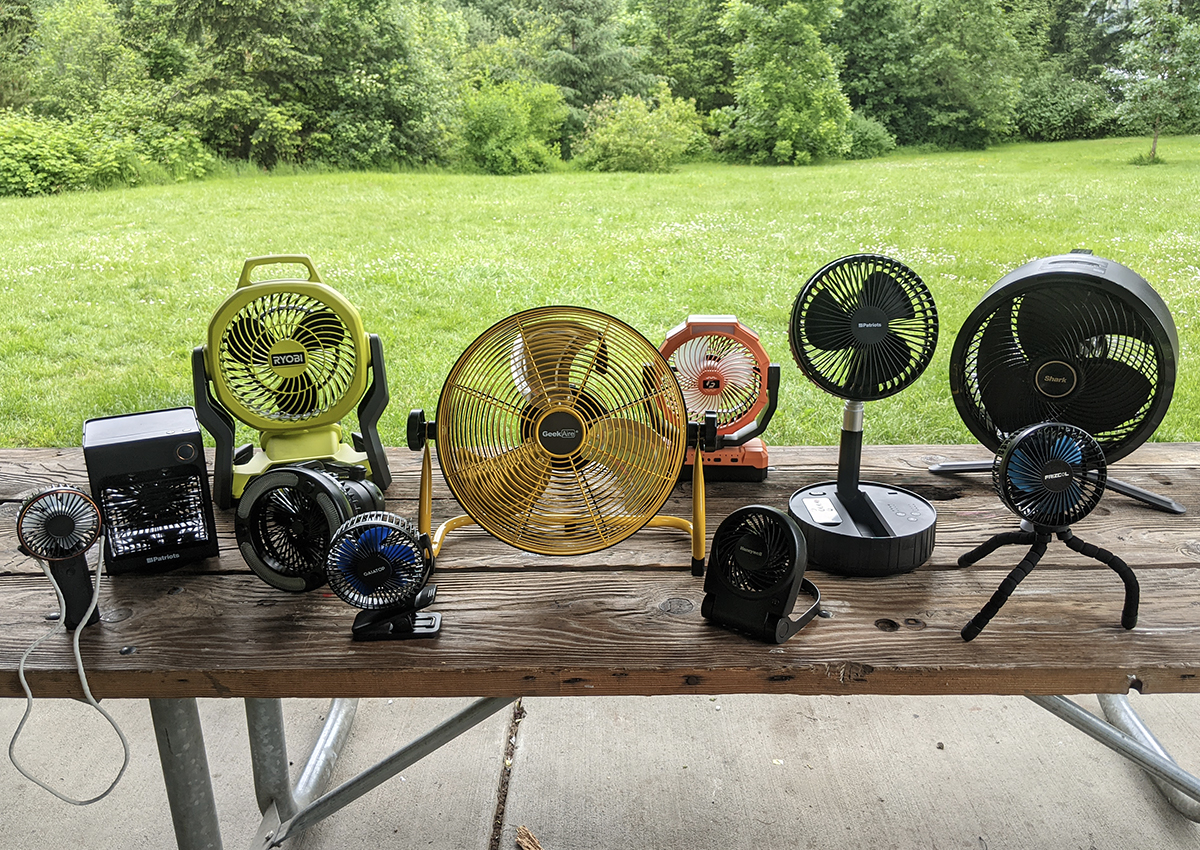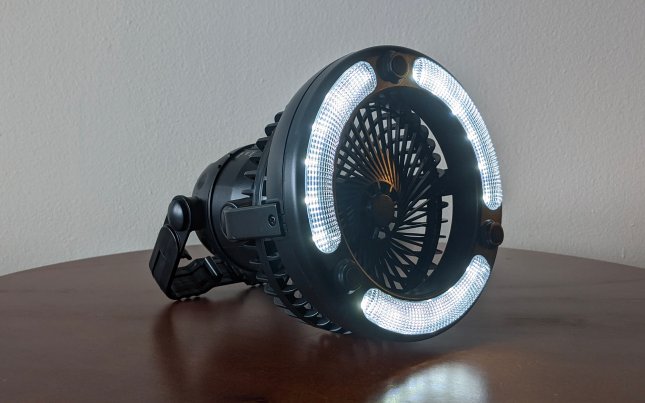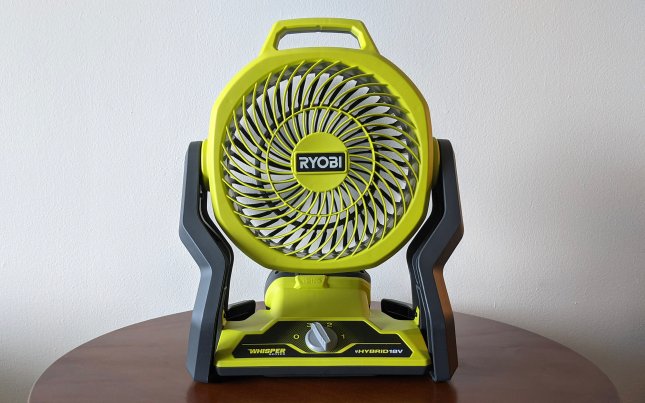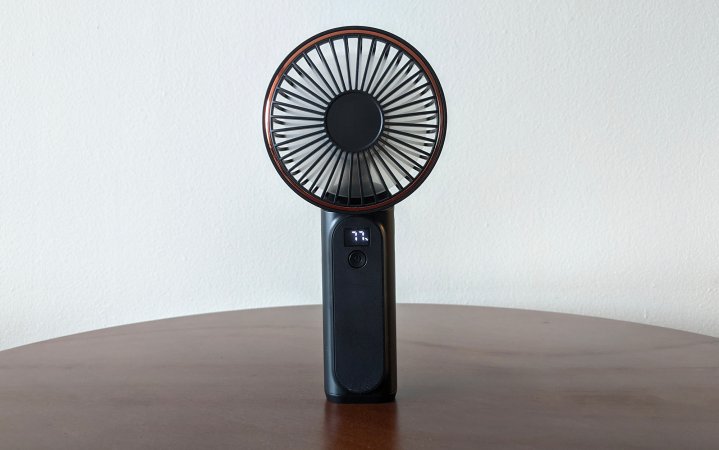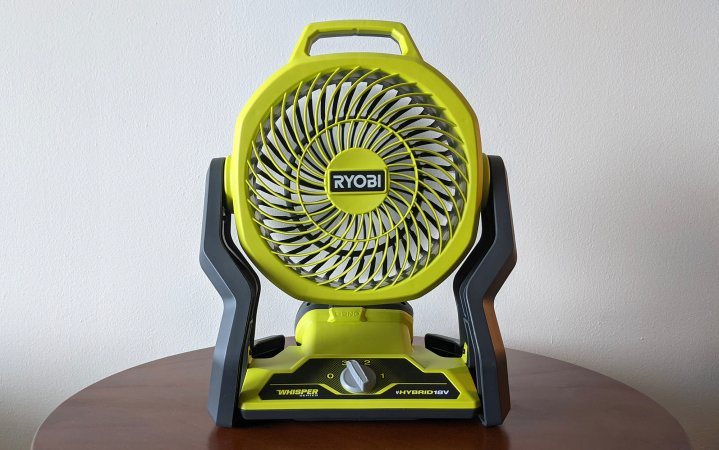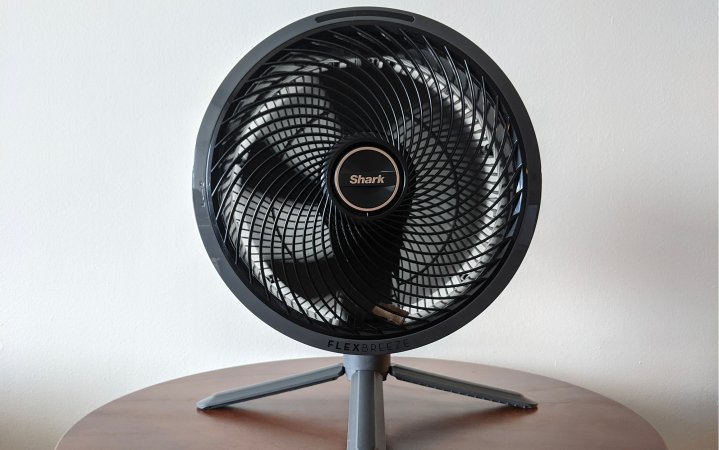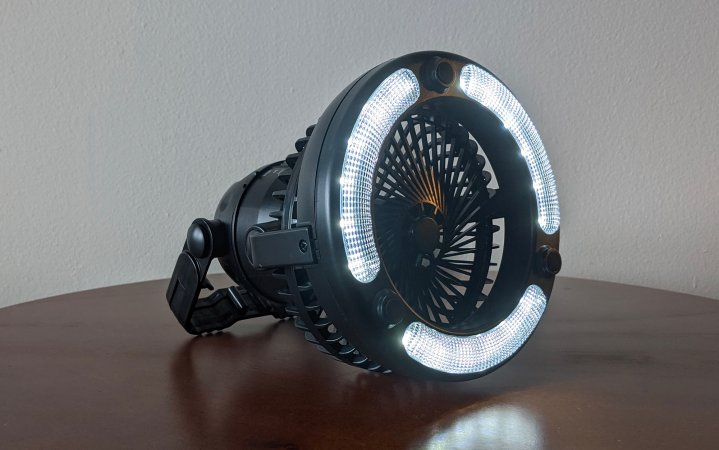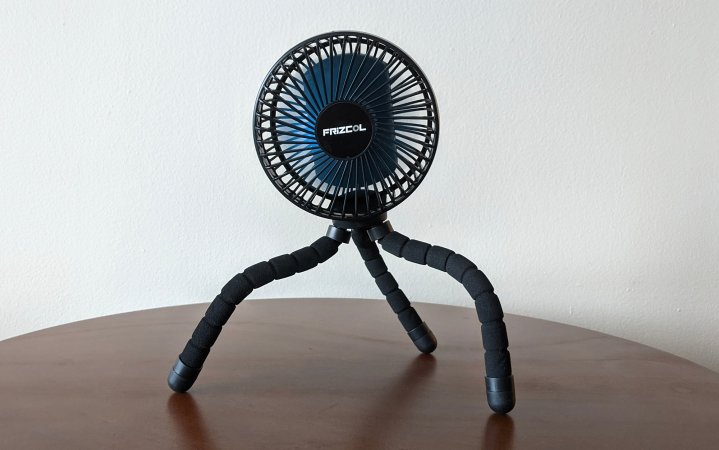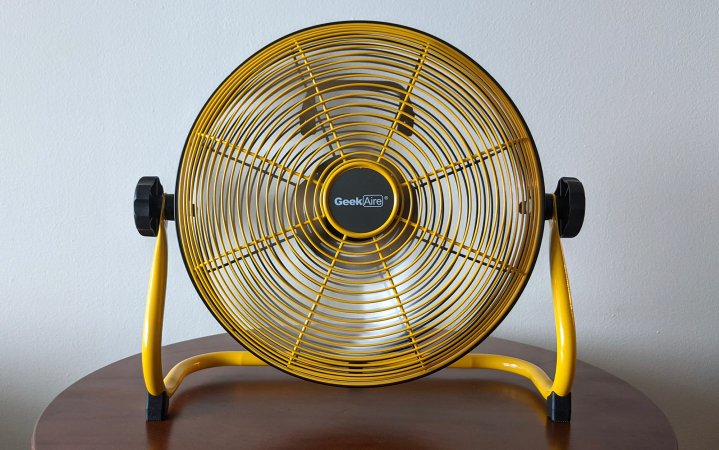We may earn revenue from the products available on this page and participate in affiliate programs. Learn More ›
It’s time to add a new piece of gear to your arsenal of tools for beating the heat of August: the camping fan. But with so many options, from little handheld minis to dedicated tent ceiling fans, which one is right for your needs? To help you choose, I tested eleven models from ten different manufacturers to find the best camping fans today.
- Best Handheld: Tunise Camping Fan
- Best Large: Ryobi Hybrid Portable Fan
- Longest Lasting: Wavmill 12000mAh Camping Fan
- Best Reach: Shark Flexbreeze
- Best for Tents: Odoland Portable Fan
- Best Small: Honeywell Turbo on the Go
- Frizcoll Portable Fan
- Geek Aire Battery-Operated Fan
How I Chose the Best Camping Fans
I put the best camping fans through a series of tests to assess their usefulness and versatility in outdoor environments. The two most important tests I conducted looked at battery life and reach. To test the battery life, I charged each camping fan to its max capacity. Then I turned them on high, started the timer, and let them run down. During this test, I checked the maximum reach of each fan. I put a measuring tape on the ground and set each fan at the end of the measuring tape. I then moved back until I couldn’t appreciably feel the breeze from the fan and marked the distance. Finally, I checked the weight of the smaller fans (the larger fans that I was unable to independently weigh are noted with an asterisk below). Finally, I considered the price, power supply, and additional features when determining the best camping fans.
| Camping Fan | Price | Weight | Power Source? | Battery Duration (on High) | Reach (Distance) |
|---|---|---|---|---|---|
| 4Patriots Breezy Cube | $45 | 1 lb, 13.1 oz | Rechargeable via USB-C | 4.5 hours | 3 feet |
| 4Patriots Compact Rechargeable Fan | $60 | 2 lbs, 9.4 oz | Rechargeable via USB-C | 4.5 hours | 7 feet |
| Frizcoll Portable Fan | $20 | 10 oz | Rechargeable via USB-C | 4 hours | 3 feet |
| Gaiatop Portable Clip-On | $15 | 8.1 oz | Rechargeable via USB-C | 2.5 hours | 4 feet |
| Geek Aire Battery-Operated Fan | $140 | 6.5 lbs* | Rechargeable via provided cord | 5.5 hours | 8 feet |
| Honeywell Turbo on the Go | $14 | 7.3 oz (10.6 oz with AAs) | 4 AAs | 7 hours | 2 feet |
| Odoland Portable Fan | $25 | 13.7 oz (1 lb, 7.4 oz with Ds) | 2 Ds | 13 hours | 5 feet |
| Ryobi Hybrid Portable Fan | $110 | 3.9 lbs* | Rechargeable via provided docking station | 3.5 hours | 12 feet |
| Shark Flexbreeze | $200 | 12.2 lbs* | Rechargeable via provided cord | 2 hours | 15 feet |
| Tunise Camping Fan | $17 | 6.8 oz | Rechargeable via USB-C | 4 hours | 3.5 feet |
| Wavmill 12000mAh Camping Fan | $35 | 1 lb, 14.3 oz | Rechargeable via USB-C | 11 hours | 4 feet |
The Best Camping Fans: Reviews & Recommendations
Best Handheld: Tunise Camping Fan
Pros
- Onboard display shows how much battery is left
- Lightweight and adjustable
- Lanyard can convert it to a neck fan
Cons
- Limited reach
- Not stable when standing upright
Key Features
- Tested Battery Life: 4 hours
- Power Source: Rechargeable via USB-C
- Tested Reach: 3.5 feet
If you’re looking for a small fan to toss into your tote on the way to the beach, it would be hard to go wrong with the Tunise Camping Fan. This was the lightest camping fan that I tested, while still clocking an impressive battery life at four hours. I also appreciated its low-key yet useful features, including a digital display showing how much of the battery was left and a nylon strand that could be attached to convert it to a neck fan. Admittedly in practice this didn’t work as well as I hoped.

Given the length of the nylon, the neck fan function will likely work better for individuals who are flat chested than those who have any sort of curve to them. It’s also worth noting that while this can be propped upright on a table or desk, the slender profile of the base means it is inherently less stable than designs with a wider bottom.
Best Large: Ryobi Hybrid Portable Fan
Pros
- Great price for its reach
- Handle on top makes it easy to transport
- Stable base that could be set on the ground or on a table
Cons
- Must be recharged using the docking station
Key Features
- Tested Battery Life: 3.5 hours
- Power Source: Rechargeable via provided docking station
- Tested Reach: 12 feet
The Ryobi Hybrid is the camping fan you want aimed at the picnic table to keep the bugs at bay. At 12 feet, it had the second best reach in my test, while boasting a significantly longer battery life (three and a half hours). Recharging this unit is a little more involved than the others I looked at — you have to use one of Ryobi’s docking ports — but you have the option to pack additional batteries to supplement it.

While other camping fans I looked at sported a bevy of special features, I ultimately appreciated that the Ryobi Hybrid Portable Fan didn’t bother with any of that. This is just a great camping fan, nothing more.
Longest Lasting: Wavmill 12000mAh Camping Fan
Pros
- Long lasting battery
- Affordable price
Cons
- Unappealing aesthetic
Key Features
- Tested Battery Life: 11 hours
- Power Source: Rechargeable via USB-C
- Tested Reach: 4 feet
The Wavmill camping fan is fairly generic in looks, features, and price, but, along with the Odoland (which uses D batteries rather than an integrated rechargeable one), it has one of the longest lasting batteries that I looked at. It packs such a punch, in fact, that there is an option to use the fan as a power bank to charge smaller electronic devices. That being said, with a reach of only 4 feet during testing, this fan will struggle to keep the bugs off the people at the end of your picnic table. Look at the Ryobi, GeekAire, or Shark models in this story for more range if that’s what you need.
Best Reach: Shark Flexbreeze
Pros
- Longest reach in my test
- Comes with an optional stand
- Oscillates
Cons
- Short battery life
- Pricey
Key Features
- Tested Battery Life: 2 hours
- Power Source: Rechargeable via provided cord
- Tested Reach: 15 feet
For those looking to supplement an off-grid cabin or generously sized vanlife setup with a higher quality camping fan than the others on this list, then look into the Shark Flexbreeze. It was the only camping fan I looked at that oscillated, meaning it can keep the bugs and the heat at bay over a wider area. It also boasted the farthest reach in my test, providing a noticeable breeze from 15 feet away.
Besides the significantly higher price tag on this fan, it’s also worth noting that, on high, the battery will only last you a couple of hours. Plan to position this one somewhere it can be plugged in the majority of the time to maximize its effectiveness.
Best for Tents: Odoland Portable Fan
Pros
- Clip to hang it from the top of a tent
- Includes a light
- Enough reach for the interior of a tent (barely)
- Long lasting battery
Cons
- Light is abrasive feeling
- Requires a less common battery (D)
Key Features
- Tested Battery Life: 13 hours
- Power Source: Two D batteries
- Tested Reach: 5 feet
Fans are a great way to keep cool at night, which makes this low-priced option from Odoland, which has a clip to hang from the top of your tent, so nice. It combines a light and fan into one, making it a multi-purpose option for reading and staying cool.

The only real issue here is that you’ll need to stock up on D batteries to ensure it will run past the first night. That being said, the aesthetics of both the light and the build are less pleasing than other options on this list, so just be aware before you make a purchase.
Best Small: Honeywell Turbo on the Go
Pros
- Affordably priced
- Easy to adjust
- Stable on a camping table or other surface
Cons
- Limited reach
Key Features
- Tested Battery Life: 7 hours
- Power Source: 4 AA batteries
- Tested Reach: 2 feet
If you’re looking for a camping fan to plonk right in front of you on the picnic table, then go with this petite and affordable option from Honeywell. Although it only reached two feet, it is easy to adjust and the base is very stable, so no worries about knocking it over when reaching for some chips. In testing, the four AA batteries it used lasted a surprisingly long time (seven hours). There is also an option to plug it into a USB-A outlet for continuous power.
Frizcoll Portable Fan
Pros
- Affordably priced
- Simple design
- Strange leg design makes it more versatile than other options
Cons
- Takes a little longer to set up
- Not the greatest reach
Key Features
- Tested Battery Life: 4 hours
- Power Source: Rechargeable via USB-C
- Tested Reach: 3 feet
This is typically referred to as a “stroller fan,” but there is no reason why you can’t take it camping. In fact, if you’d like to wrap it around the pole of one of the best canopy tents or the arm of one of the best camping chairs, it’s what you should snag. While this fan has reasonable reach and battery life for what it is, be aware that it’s more complicated to simply set up on a picnic table than other options on this list.
Geek Aire Battery-Operated Fan
Pros
- Long-lasting battery
- Good reach
Cons
- No handle
- Expensive
Key Features
- Tested Battery Life: 8 feet
- Power Source: Rechargeable via provided cord
- Tested Reach: 5.5 hours
The Geek Aire fan was a close second for best large fan in my test. While it had the longer battery life compared with the Ryobi option, ultimately, the higher cost and lower reach kept it out of the top spot. I also wish that it sported a handle like the Ryobi model as that makes it significantly easier to move around from place to place. But the aesthetics of this camping fan compared to the pale neon green of the Ryobi camping fan are undeniable, and it’s a solid option, especially if you can find it on sale.
The Rest of the Field
While several of the camping fans I tested were strangely hard to charge up, there was none that I struggled with more than the affordably priced Gaiatop. It would pull a watt or so out of my power bank at a time with the red charge light aglow and then go off after 30 seconds or so. I tried a number of different USB-C charging cables and power stations to try and get around this issue to no success. So while it’s difficult to say whether the poor performance in the timed test is a true reflection of this camping fan’s abilities, it’s nevertheless a good idea to choose one of the other options on this list.
While I enjoyed the two solar chargers that I checked out from 4Patriots, I was unfortunately less impressed by their camping fans. Both were somewhat large and somewhat heavy with limited reach and battery life. I didn’t enjoy the aesthetics of their plastic construction and found their extra features less useful (or in the case of the remote that came with the Compact Rechargeable fan, non-functioning) than I would have hoped.
Things to Consider Before Buying One of the Best Camping Fans
Purpose of the Best Camping Fans
One of the most important considerations when choosing a camping fan is where you intend to set it up. For some people, daytime use, when temperatures soar, is the most important factor. Others intend to turn theirs on primarily at dusk, when the mosquitoes come out to play. A camping fan can add a little more coverage in conjunction with the best mosquito repellents. Others still plan to use their camping fan only at night, to keep temperatures down while they try to sleep. Consider the ways you intend to use your camping fan before making a purchase.
Size of the Best Camping Fans
Some of the camping fans on this list can provide enough cool air for groups of people, while others are only meant for individuals. Choose a camping fan with enough oomph to keep you cool in the conditions you expect to face.
Versatility of the Best Camping Fans
While most camping fans only have one intended purpose (or are only really able to function well for one intended purpose), others allow the users to set up their fan in a number of different configurations, including hanging it from the tent ceiling, setting it at the opposite side of a picnic table, or even wrapping it around the pole of a camping canopy. Consider the different setups you are likely to opt for when choosing the camping fan that is right for you.
Power Source for the Best Camping Fans
One of the biggest differences between a camping fan and the box fan you already have at home is its power source. Rather than a typical plug that fits into a household electrical outlet, camping fans rely on one of two power sources: batteries (such as AA or D) or an internal batteries.
Fresh batteries can be hard to procure while camping, and fan power usage can vary considerably. It is recommended that you bring three or four sets of spare batteries with you. Otherwise your camping fan might not have enough juice to last your entire trip. If you plan to use a power bank for your camping fan, consider sizing up to a larger camping power bank or bringing along a solar panel. You may have to recharge the bank on trips where you will be out for multiple days.
Safety
There are a number of ways that camping fans can inadvertently cause injury. Consider potential pain points in advance to help prevent any negative outcomes. If you are camping somewhere with variable weather, for instance, consider whether your camping fan will need to be covered at nighttime or when not in use. For anyone that is planning to hook up their camping fan overhead, look to see how secure the connection point is (those velcro tabs may not cut it). Check ahead of time if they will need to be reinforced with something sturdier. Finally, if you are camping with small children (and their small fingers), ensure that fans are out of reach and have safety mechanisms to prevent injury.
FAQs
Camping fans typically cost between $15 and $200, depending on functionality, versatility, and long-term durability.
For many people, camping fans are a luxury. You might purchase one to entice a loved one into the outdoors, or to make the hottest parts of the day somewhat more comfortable. In certain parts of the United States, however, where temperatures can soar into triple digits with humidity levels to match, they can take on greater importance — especially if you are also contending with mosquitoes. In these climates, camping fans can go from being a nice-to-have to a must-have.
Whether or not a camping fan will cool a tent depends on a number of factors. The first is the power of the camping fan itself — a more powerful unit will do more to keep you cool than a less powerful one. Placing something cold in front of the fan can also help lower the temperature (i.e., turning it into a swamp cooler).
Next is the setup of the tent. If you have the rainfly on and all the doors closed, the heat of the day will be trapped inside your tent even as the nighttime temperatures cool. You also won’t get the benefit of air circulating naturally outside. Opening and securing the tent doors, along with vents your tent has, can help lower the temperature. Finally, whether or not a fan can cool a tent does in part depend on just how hot it is outside. Even the most powerful fan will only reduce your experience of the heat by 10 degrees or so. Check the nighttime lows before heading out on your trip to determine if you’ll be comfortable.
There are two main ways to run a fan while camping: batteries (including rechargeable batteries) or an external power source. The advantages of the former are that you can move your fan without needing to drag the power source along with it. The downside is that you’ll need to remember to bring extra batteries or, if using a built-in rechargeable battery, deal with a power source that tends to fade over time. External power sources are becoming increasingly common for car camping and overlanding but if you don’t already have one as part of your camping arsenal, you’ll need to acquire one first.
Final Thoughts
Camping fans might seem like a luxury for people living in more temperate parts of the country, but anyone living in the South or other hot, humid climes knows that they can be a necessity. A portable fan might be the reason it’s possible to go camping in the first place. If you’re looking to expand your region’s camping season, or convince a first-time camper to give sleeping in the outdoors a try, a camping fan is a no-brainer. Fortunately, there are a number of brands on the market today. In addition to the best camping fans on this list, there are units available from Ryobi, Odoland, Geek Aire, Shark, Honeywell, and more.
- Best Handheld: Tunise Camping Fan
- Best Large: Ryobi Hybrid Portable Fan
- Longest Lasting: Wavmill 12000mAh Camping Fan
- Best Reach: Shark Flexbreeze
- Best for Tents: Odoland Portable Fan
- Best Small: Honeywell Turbo on the Go
- Frizcoll Portable Fan
- Geek Aire Battery-Operated Fan
